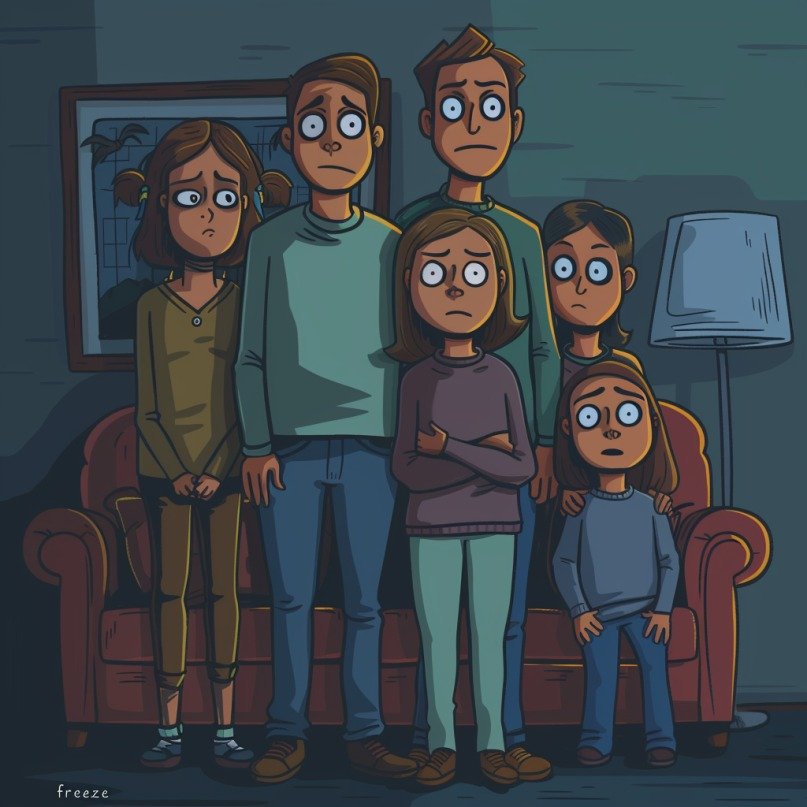Navigating the Nuances of the 7 F's: Understanding Our Responses to Everyday Stressors
It's crucial for us to explore how we all respond to dangers, threats, or challenges, particularly within the context of family life. But really, this insight applies to any situation involving others. Over time, our response mechanisms have evolved beyond the basic instincts of fight, flight, and freeze. Walter B. Cannon originally introduced the idea of the 'fight or flight response' to explain our acute reactions to immediate threats. However, the challenges we encounter in modern Western societies are rarely isolated, acute events. Instead, they are persistent, unfolding within the very walls of what should be our sanctuaries—our homes and families. What was once a safe haven from danger might now, ironically, be the very source of our stress and the trigger for our threat responses.
This topic is especially relevant when we consider family dynamics. Here, we don't just contend with overtly traumatic events. We also navigate through more subtle yet persistent stressors like ongoing domestic tension, parental neglect, or the struggles that come from a parent being physically or emotionally distant. While the word "trauma" is often mentioned now in popular culture, it's important to recognize that our discussion here includes a wide range of stressful experiences—those continuous pressures that many families face day in and day out. (Basically this includes what we consider trauma or adverse childhood events, but is not limited to it.)
We must take a moment to reflect on a profound transformation in our social fabric: the shift from communal living, which once nurtured our collective survival and well-being, to the isolated pillars of modern family life. In this new world, the Western ideal glorifies self-reliance, painting the solitary climb to success as a noble quest. But, this veneration of independence, akin to being told to cross an ocean with nothing but a rowboat, is a double-edged sword. It's touted as the pinnacle of personal achievement—"pulling yourself up by your own bootstraps." However, this approach is more akin to a siren’s call, luring us into turbulent waters where the very qualities that ensure survival—community, collaboration, compassionately sharing burdens—are left behind. This drastic shift heaps immense stress on both parents and children, fundamentally altering the nature of our challenges and the ways we confront them. The irony is stark: in striving for self-sufficiency, we have unwittingly nurtured the very conditions that fray our individual and collective well-being.
Understanding the 7 F's—how we flock, fight, flee, freeze, fawn, flood, and flop—can give us valuable insights into our behaviours and those of the people around us. Recognizing these patterns isn't just about identifying problems; it's about fostering empathy and finding healthier ways to support each other through life's challenges.
Moving beyond Fight or Flight
The expanded model of Walter B. Cannon's "fight or flight" response, now encompassing a set of seven responses—collectively known as the 7 F's—provides a more comprehensive framework for understanding human behaviour in the face of stress and threats. These responses, varying from highly active to distinctly passive, reflect complex physiological and psychological mechanisms. Each response can be dominant or subordinate (as it happens in the wild also) depending on the individual, the specific context, or the nature of the threat. Below, we explore each response:
Flock: Typically a passive response, flocking involves seeking safety through numbers and social conformity. For example, in an office environment during a sudden crisis like a fire alarm or an emergency lockdown, employees might look to management or follow the majority's behaviour on whether to evacuate immediately or seek more information.
Flight: An active response, flight entails escaping from the immediate source of stress or danger. An example of this might be a person leaving a crowded room when feeling claustrophobic or abruptly ending a conversation that is causing severe anxiety.
Fight: This is another active response where the individual confronts the threat head-on. This could be someone defending their viewpoint in a heated debate or a person standing up against unfair practices in the workplace.
Freeze: Considered a passive response, freezing involves a temporary halt in physical and mental activity, often as a protective dissociation from reality. During a robbery, for instance, a store clerk might find themselves physically incapable of moving or calling for help, as their body and mind temporarily "shut down" to cope with the overwhelming fear.
Fawn: A passive response, fawning involves appeasing others to avoid conflict or to gain approval, often at the expense of one's own needs. A clear example is someone who habitually takes on extra tasks at work, despite already being overloaded, simply to avoid disappointing colleagues or supervisors.
Flood: This passive response is characterized by an overwhelming emotional reaction disproportionate to the actual situation. It could manifest when someone bursts into tears during a relatively mild critique, overwhelmed by the emotional residue of past criticisms.
Flop: Also a passive response, flopping involves a collapse of physical or emotional strength. This could occur in an extreme situation, such as a person fainting at the sight of blood or becoming catatonic after receiving devastating news.
While each of these responses can be predominant in certain individuals, it is important to recognize that most people will exhibit a combination of these responses, depending on the situation or the people involved. For instance, a person might typically respond with fight in professional settings where assertiveness is valued, but resort to fawn in personal relationships where harmony is prioritized.
Moreover, it is not uncommon for individuals to switch between responses based on the effectiveness of the initial reaction. For example, someone might first try to fawn in an attempt to defuse a hostile situation, but if that proves ineffective, they might switch to fight as a form of self-defense or assertiveness. These adaptive strategies underscore the complexity of human behaviour in response to stress and threat.
The Culturally Conditioned Self – You are Not What You’re Afraid Of
In Western cultures, our responses to stress and threats are often shaped by societal preferences and biases, creating a hierarchy of acceptability among the 7 F's responses. Active responses like "fight" and "flight" are commonly viewed with judgment, where direct confrontation may label someone as aggressive, and withdrawal could be seen as unreliable. In contrast, passive responses such as "flock" and "fawn," which involve seeking safety in numbers and appeasing others, are more valued. These culturally favoured responses are often reinforced, mistakenly perceived as personality traits rather than adaptive mechanisms to fear or threat. This conditioning not only influences individual behaviours but also affects how we interpret and interact with others, potentially masking the common emotional foundations across different responses.
Additionally, factors like neurovarience and alexithymia complicate our understanding of how individuals perceive and communicate emotions. Alexithymia, characterized by difficulty in identifying and expressing emotions, can hinder effective communication and exacerbate challenges in interpersonal interactions. It may influence the specific stress responses triggered in individuals, affecting how they handle emotional threats.
When we experience fear or alarm, it fundamentally disrupts our sense of safety, increasing anxiety and affecting concentration and sensitivity to nonverbal cues. In response, they may become hypervigilant, scanning for threats as a survival strategy. Recognizing that these varied responses stem from a common root—a fundamental fear and the instinct to protect oneself—is crucial for fostering empathy and understanding. Without this insight, there's a risk of misinterpreting actions and intentions, overlooking the shared emotional experiences among us.
Understanding these dynamics highlights the importance of not solely relying on others for change but recognizing our responsibility in cultivating personal safety and security. This task, particularly challenging for dependent children, underscores the need to build supportive communities to alleviate pressures on individuals/parents. As adults, we can reassess and modify our stress responses, which may be mistaken for fixed personality traits. By developing self-soothing techniques, establishing personal security, and building trust within ourselves and with others, we foster environments that support well-being and mutual understanding.
What Do We Do About What We Now Know?
Given the understanding that our responses to fear and threat are deeply ingrained and often mistaken for personality traits, it's crucial to engage in practical strategies to modify these responses to increase health, joy and wellness. Here are some actionable steps that to begin:
Awareness and Identification: The first step involves cultivating a deep awareness of your own response patterns. I encourage you to observe how you react in different situations and identify which of the 7 F's responses you predominantly exhibit. Journaling can be an excellent tool here, helping you track your reactions and reflect on the triggers and the contexts in which they occur.
Understanding the Origin: Once you have a clear sense of your typical responses, the next step is to explore where these reactions may stem from. This exploration often leads us back to your past experiences and the conditioning you received during childhood. The point is not to get stuck in the past, but to help you understand why these patterns may have been cultivated and then habituated.
Developing Alternative Responses: With a better understanding of your natural inclinations, you can begin to work on developing healthier ways to respond. Responses based on love, wellness, knowing of safety instead of perceived fears or threats. (Note – as mentioned at the beginning, these strategies are effective for real threats – run away from a bear, move out of the way of a moving vehicle, they are less effective for our modern-day lives.)
Building Emotional Regulation Skills: It’s crucial to learn skills to manage and soothe intense emotions. Practices like mindfulness, meditation, deep breathing exercises, or progressive muscle relaxation can be very effective. These techniques will help reduce the intensity of your emotional responses, enabling more thoughtful and conscious actions.
Strengthening Social Supports: To combat the feelings of isolation that may arise from responses like 'flight' or 'flop,' it’s important to build or strengthen your social connections. Whether it’s through support groups, community activities, or closer familial ties, these relationships can offer you emotional security and a sense of belonging.
Creating a Personal Well-Being Plan: Having a personal well-being plan in place can be incredibly helpful. This plan might include identifying safe places, key supportive people you can contact, and activities that bring you comfort and calm. Such a plan is a practical tool you can rely on to manage stress and anxiety effectively.
By integrating these strategies into your daily life, you will gradually learn to replace instinctual fear responses with actions that promote greater well-being and emotional, mental, social and physical health. This journey isn’t about suppressing your natural reactions; rather, it’s about transforming them into conscious responses that support a healthier, more flourishing life.
References:
Bell, H., Kulkarni, S., & Dalton, L. (2003). Organizational prevention of vicarious trauma. Families in Society: The Journal of Contemporary Social Services, 84(4), 463–470. https://doi.org/10.1606/1044-3894.131
Birnbaum, S. (2019). Confronting the social determinants of health: Has the language of trauma informed care become a defense mechanism? Issues in Mental Health Nursing, 40(6), 476–481. https://doi.org/10.1080/01612840.2018.1563256
Boylan, M. (2021). Trauma informed practices in education and social justice: Towards a critical orientation. International Journal of School Social Work, 6(1). https://newprairiepress.org/cgi/viewcontent.cgi?article=1071&context=ijssw
Butler, L. D., Critelli, F. M., & Rinfrette, E. S. (2011). Trauma-informed care and mental health. Directions in Psychiatry, 31(3), 197–212.
Johnson, Nicole and Gianvito, Ida, "Cultivating Trauma-Informed Spaces in Education: Promising Practices Manual" (2022). Trauma-Informed Education. 1. https://source.sheridancollege.ca/centres_sgg_2023_trauma_education/1
Malenfant S, Jaggi P, Hayden KA, Sinclair S. Compassion in healthcare: an updated scoping review of the literature. BMC Palliat Care. 2022 May 18;21(1):80. doi: 10.1186/s12904-022-00942-3. PMID: 35585622; PMCID: PMC9116004.
Perry, B. D. (2006). Fear and learning: Trauma-related factors in the adult education process. New Directions for Adult and Continuing Education, 110, 21–27. https://doi.org/10.1002/ace.215
Ryder, G., & Gepp, K. (2022). The fawn response: How trauma can lead to people-pleasing. PsychCentral. Retrieved from https://psychcentral.com/health/fawnresponse#:~:text=The%20Fawn%20Response%3A%20How%20Trauma%20Can%20Le ad%20to%20People%2DPleasing&text=Difficulty%20saying%20'no%2C'%20fear,others %20instead%20of%20your%20own%3F
Sinclair S, McClement S, Raffin-Bouchal S, Hack TF, Hagen NA, McConnell S, Chochinov HM. Compassion in Health Care: An Empirical Model. J Pain Symptom Manage. 2016 Feb;51(2):193-203. doi: 10.1016/j.jpainsymman.2015.10.009. Epub 2015 Oct 26. PMID: 26514716.
Substance Abuse and Mental Health Services Administration. (2014). A treatment improvement protocol: Trauma-Informed care in behavioural health services. U.S. Department of Health and Human Services. Retrieved on November 11, 2022, from https://store.samhsa.gov/sites/default/files/d7/priv/sma14-4816.pdf
van der Kolk, B. (2014). The body keeps the score: Brain, mind, and body in the healing of trauma. Penguin Books
Zosky, D. L. (2013). Wounded healers: Graduate students with histories of trauma in a family violence course. Journal of Teaching in Social Work, 33(3), 239–250. https://doi.org/10.1080/08841233.2013.795923







